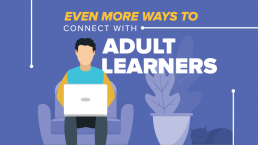Strategies to Increase Enrollment With Adult Learners: Part 2
Strategies to Increase Enrollment With Adult Learners: Part 2
The second installment of our two-part series
Welcome back to the second part of our series on enrollment strategies for increasing your adult learner population. In my last blog, I discussed how adult learners may be able to give institutions a much-needed boost to their enrollment by offsetting the decline of traditional-age students. I also shared two strategies on how to lay the foundation for attracting the right adult learner. In this blog, I go further into how you can engage with the adult learner as an individual.

"I was profoundly grateful to have my past work recognized by the educational institution I had chosen, and it absolutely motivated me as I navigated the ups and downs of going back to school mid-career, changing careers."
- Patricia Nagy-Travieso, current adult learner
Strategy 3: Recognize Life Experiences
Barriers to Enrolling
The idea of going back to school has been in adult learners’ minds for quite some time, but as more time passes, more obstacles appear. Lack of time, cost to attend, and fear of academic preparedness are major obstacles adults face when considering returning to, or beginning, college. Identifying the value of their life experiences and addressing their obstacles can help adult learners take the initial steps to enroll. Getting adults to recognize their own experiences — and value — will help them overcome their perceived inadequacies.
Value to Classroom
Dr. Charles Backes, a former colleague of mine with more than 30 years in adult and career education says, “Having adults in my courses changes the entire course along with the way that I teach it. In a traditional, child-centered setting, content is delivered in such a way that the young learner can put it away to be used at a much later time. For adults, particularly those who are in the workforce, application can be immediate. In fact, adult learners prefer to be able to conceptualize and apply information right away to tasks and situations that are current and possibly problematic. When I can provide specific examples of content application and tie it to something they have experienced, it brings the content of the course to life and makes it relevant. It can also lead to meaningful discussions for the whole class, whereby much of the course content may be actually delivered by the students themselves under the direction of the instructor.”
Life experiences help with learning and processing information, especially when earning a degree. Think about how the classroom and learning experience will change with adult learners in attendance — what value they bring and the positive impact on traditional students.
Prior Learning Credits
Adult learners’ life experiences have tremendous value and are an opportunity to attract them to earn a degree. For example, Patricia Nagy-Travieso is a psychology major, returning to college after working 20 years as a writer for ELLE magazine. The institution she attends gave her credit for required English courses after reviewing her portfolio and evaluating her work experience. Trish said, “It felt both incredible and humbling for me to get credit for my work at ELLE magazine, where I had spent over two decades of what would become the first half of my professional career. I perceived it as a recognition for my years-long experience in branding, media management, and content creation, and it ultimately had a concrete impact on my future education as I embarked on returning to school to pursue a completely new professional path in psychology. I was profoundly grateful to have my past work recognized by the educational institution I had chosen, and it absolutely motivated me as I navigated the ups and downs of going back to school mid-career, changing careers. The credits for my portfolio were a supporting and motivational validation in a professional decision that is not always easy to make, and helped to make the pieces fall into place. I now have a year left before I graduate with a BS in psychology, and I couldn’t be more excited about my studies, and my future.”
Creating a clear process for evaluating and providing academic credit based on life experiences not only provides a strong message to adult learners that those experiences have value and are appreciated by your institution, but also makes it that much faster and financially possible to start or complete their degree.
Strategy 4: Effective Communication
Once you have identified who your adult learners are, the programs they are interested in and the way they like to receive communications, your job is done, right? Hardly.
Communicating with adult learners is critical as an enrollment strategy and where the rubber meets the road. Institutions should review the entire communication journey for adult learners — from website and application to emails and events, and reflect on whether the language being used is appropriate for this audience. In a nutshell, you should speak to adult learners differently than you would speak to traditional-age students because they have vastly different experiences and perspectives.
Using the right words, in the right channels, at the right time is critical, but it also requires significant time, resources, and energy to craft, execute, and monitor your campaign’s progress.
Although there will always be challenges in higher education, this is an unprecedented time because there are just so many factors that have many institutions scrambling to address their declining enrollment with declining resources.
Don’t worry, though, you’re not alone. Spark451’s experienced strategy team has the resources to help institutions like yours identify potential adult learners and to craft a sound plan to help usher them through the enrollment funnel.
To discuss your institutions’ strategy to enroll adult learners, and Spark451’s innovative solutions and proven results with adult learners, please reach out.

